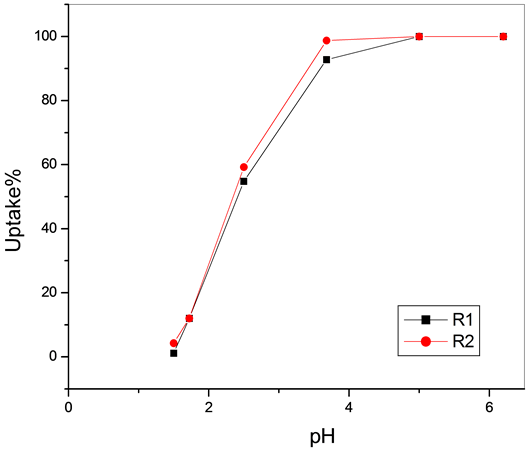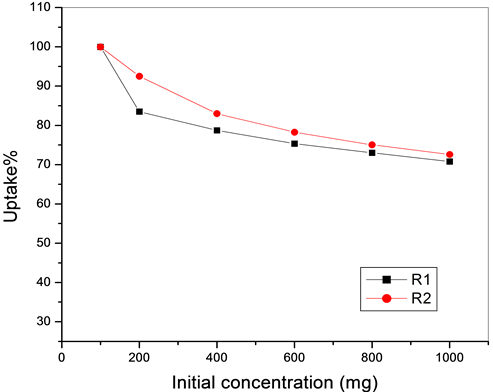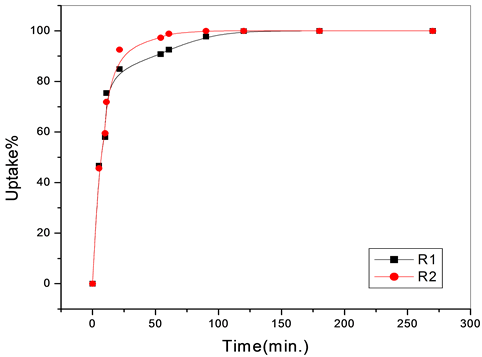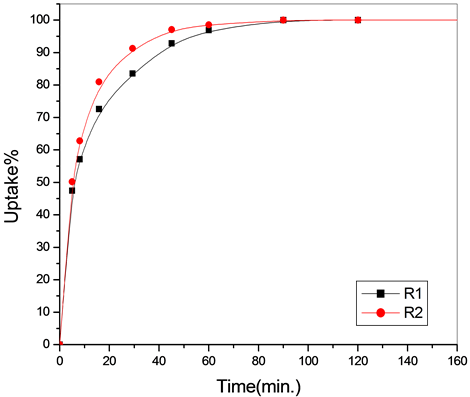Open Journal of Inorganic Chemistry
Vol.05 No.02(2015), Article ID:54375,10 pages
10.4236/ojic.2015.52004
Batch Studies for Sorption of Ga(III), Cu(II), Ni(II) and Zn(II) Ions onto Synthetic Polymeric Resins
H. A. Hanafi1,2, M. Abd Elsamad2,3
1Cyclotron Project, Nuclear Research Centre, Atomic Energy Authority, Cairo, Egypt
2Collage of Science and Humanities, Al-Quwayiyah-Shaqra University, Saudi Arabia
3Radiated Pollution Department, Hot Laboratories Center, Atomic Energy Authority, Cairo, Egypt
Email: white_heart200014@yahoo.com
Copyright © 2015 by authors and Scientific Research Publishing Inc.
This work is licensed under the Creative Commons Attribution International License (CC BY).
http://creativecommons.org/licenses/by/4.0/



Received 16 December 2014; accepted 2 March 2015; published 3 March 2015
ABSTRACT
Poly(acrylamide-acrylic acid-dimethyl amino ethylmethacrylate), p(AM-AA-DMAEM) and Poly(acry- lamide-acrylic acid)-ethylene diamine tetracetic acid disodium, p(AM-AA)-EDTANa2 were prepared by gamma radiation-induced template polymerization technique. The prepared polymeric materials were used for the sorption of Ga(III), Cu(II), Ni(II) and Zn(II) in aqueous solution. The effect of pH, weight of resins, metal ion concentrations and contact time on the sorption of these metal ions were studied.
Keywords:
Sorption, Gallium (III), Zinc (II), Copper (II), Nickel (II) and Polymeric Resins

1. Introduction
Polymeric substrates are being continuously developed and used for the purpose of complexation with metal ions either for ion-exchange or selective adsorption purpose. These polymeric ligands are tailored synthesized to remove certain metal ions or groups from aqueous media [1] -[3] . A number of chelating polymers, containing different active groups such as carboxylic, amide, amino amidoxime and hydroxamic groups, were prepared by different polymerization techniques [4] - [19] . The functional groups are interacted with the metal ions through complexation or formation of covalent bonds by ion-exchange mechanism [17] - [21] . These resins contain as a rule one or more donor atoms which can form a coordination bond with the metal ion. The selective ion-exchange phenomenon in a system mainly depends on the combination of three factors, the metal ion chemistry in aqueous solution and the resin, the structure of the functional groups in the resin phase and the macromolecular structure as present under the separation condition [21] . The efficiency of the resins increases by decreasing the degree of crosslinking. The resins can be regenerated and reused for continuous process [22] . The removal process of the metal ions from the solution depends on the type of the metal ion, pH of the solution, metal ion concentration and the properties of the ion exchanger such as crosslinking degree, swelling and the type of the ligand [23] .
Different polymeric resins were synthesized and used for the separation of the metal ions from aqueous solutions investigated by several authors. Poly(ethyleneimine vinyl benzaldehyde) was used for the separation of Fe(III) from aqueous solution containing Cu(II), Ni(II), Co(II), Fe(II), Mn(II) and Zn(II) [24] , while poly(1-β- acrylamidoethyl-3-hydroxy-2-methyl-4(1H)-pyridinone N,N dimethyl acrylamide) was used for chelating of Fe(III) from poisoned blood plasma [25] . Polystyrene-supported-1-(2-aminoethyl) piperazine was used for the removal of Au(III), Pb(II) from Cu(II), Ni(II) and Fe(III) in 0.1 M HCl [26] . Cu(II) was separated from a solution containing Cd(II), Co(II), Ni(II), and Zn(II) at pH > 2.5 onto poly(glycidyl methacrylate) modified resins by pyrazole, imidazole, and 1,2,4-triazole [27] , while Zn(II) was also separated from Cu(II), Ni(II) in aqueous solution at pH > 4.5 onto a modified poly(glycidylmethacrrylate) [28] . Poly(amidoxime) was used for the removal of Cu(II), Pb(II), Zn(II), Cr(III) and Ni(II) at pH 5 in aqueous solution [29] .
Poly(N-acryloyldiethyliminodiacetate acrylic acid) was used for the removal of 152Eu at pH 4 [30] . Poly(hy- droxymic acid) was used for separation of Fe(III) from solution containing Cu(II) and Ni(II) at pH < 4 [31] and poly(methyl acrylohydroxamic acid) was also used the separation of metal ions such as Cu(II), Ni(II), Co(II), Pb(II) and Fe(III) at pH 3.5 - 5 [32] . Polymeric composite such as poly(acrylamide-acrylic acid)-EDTANa2, poly(acrylamide-acrylic acid)-montmorillonite, poly(acrylamide-acrylic acid)-KNiHCF, poly(acrylamide-acrylic acid)-KZnHCF, poly(acrylamide-acrylic acid-DMAEM)-KNiHCF were used for the removal of metallic ions such as Cu(II) and Cr(II) as test ions from waste water and were also used for treatment of radioactive liquid waste containing radioactive isotopes such as 60Co and 152Eu [33] . Generally, acrylamide polymeric materials were used for the removal of various metallic ions, heavy metal, and radioactive isotopes from their aqueous solution [4] - [19] [33] . In the present work, acrylamide polymeric resins are used for the sorption of Ga(III), Cu(II), Ni(II) and Zn(II).
2. Experiment
2.1. Materials
N, N-methylene diacrylamide andacrylamide, were obtained from BDH, acrylic acid monomer and dimethylaminoethyl methacrylate were obtained from Merk (Germany), and EDTANa2 was obtained from Oxoford laboratory reagent.
2.2. Preparation of Polymeric Materials
Polyacrylamide, p(AM), was prepared by gamma radiation-initiated polymerization of 10% acrylamide monomer solution using gamma radiation at a dose 10 kGy [17] .
P(AM-AA-DMAEM), [R1], was prepared by template copolymerization of acrylic acid and dimethylaminoethyl methacrylate in the presence of N, N-methylene diacrylamide (DAM) as across-linker [33] .
P(AM-AA)-EDTANa2, [R2], was prepared by gamma radiation induced template polymerization of acrylic acid on p(AM) in the presence of EDTANa2 and N, N-methylene diacrylamide (DAM) as across-linker.
2.3. Batch Sorption Studies
The ion exchange behavior of the metal ions of Ga(III), Cu(II), Ni(II) and Zn(II) towards the synthesized polymeric materials was studied using the batch technique where, 40 mg of each resin was equilibrated with 20 ml aqueous solution containing the desired metal ion. The uptake percentage of the studied ion on the polymeric materials was determined using ICP―a JobinYvon ICP-OES spectrometry model Ultima2. The uptake percentage was determined using the following equation:

where A0, A are the concentration of the metal ions before and after addition the resin, respectively.
3. Results and Disscussion
3.1. Effect of pH
Effect of pH on the Sorption of Metalions
The sorption of Ga(III), Cu(II), Ni(II) and Zn (II) was studied on polymeric materials of p(AM-AA-DMAEM) and p(AM-AA)-EDTANa2 at different pH values as shown in Figures 1-4. The data showed that the sorption of Ga(III), Cu(II), Ni(II) and Zn(II) on p(AM-AA-DMAEM) and p(AM-AA)-EDTANa2 increased with increasing the pH value. This can be attributed to the effect of pH on the functional groups of the polymeric materials. At low pH value, the amide and amino groups are most present in protonated form, leading to imidation of amide groups with the formation of intermolecular cross-linking between polymeric chains, which inhibits their complexation with metal ions. With increasing pH, the degree of protonation decreases which leads to increasing interaction between polymeric materials and metal ions. By increasing pH, the degree of ionization of carboxylate groups (pKa = 2.45) of polymeric materials increases as well, which facilitates the cation exchange. Moreover,
Figure 1. Effect of hydrogen ion concentration on the uptake of Ga(III) on p(AM-AA-DMAEM) and p(AM-AA)-EDTANa2.
Figure 2. Effect of hydrogen ion concentration on the uptake of Gu(II) on p(AM-AA-DMAEM) and p(AM-AA)-EDTANa2.
Figure 3. Effect of hydrogen ion concentration on the uptake of Ni(II) on p(AM-AA-DMAEM) and p(AM-AA)-EDTANa2.
Figure 4. Effect of hydrogen ion concentration on the uptake of Zn(II) on p(AM-AA-DMAEM) and p(AM-AA)-EDTANa2.
at high pH the amide and amine groups of the resins can interact with metal ions [32] [33] . It was found that the optimum pH values for the removal of Ga(III), Cu(II), Ni(II) and Zn(II) were found to be 3.5, 5, 6, 4, respectively. This can be attributed to the presence of metal ions as free ions in the solution [32] . At higher pH value > 6, the metal ions form metal hydroxides.
3.2. Effect of Weight of Polymeric Materials
Different weights of polymeric materials of p(AM-AA-DMAEM) and p(AM-AA)-EDTANa2 were used for the removal of Ga(III), Cu(II), Ni(II) and Zn(II) individually from aqueous solution at pH = 4.4, 4.5, 5.5 and 5.6, respectively. The results are shown in Figures 5-8.
The uptake percentage increases with increasing the weight of the polymeric materials and reached its maximum value at 40 mg for all metal ions, which means that this is optimum concentration for the sorption process.
Figure 5. Effect of resin weight of p(AM-AA-DMAEM) and p(AM-AA)-EDTANa2 on Ga(III).
Figure 6. Effect of resin weight of p(AM-AA-DMAEM) and p(AM-AA)-EDTANa2 on Cu(II).
Figure 7. Effect of resin weight of p(AM-AA-DMAEM) and p(AM-AA)-EDTANa2 on Ni(II).
Figure 8. Effect of resin weight of p(AM-AA-DMAEM) and p(AM-AA)-EDTANa2 on Zn(II).
3.3. Effect of Metalion Concentration
The effect of sorption of Ga(III), Cu(II), Ni(II) and Zn(II) from aqueous solution on p(AM-AA-DMAEM) and p(AM-AA)-EDTANa2 was studied.
The results are shown in Figures 9-12, which show that the uptake decreases with increasing metal ion concentration due to the specific capacity of the polymeric materials.
3.4. Effect of Contact Time
The variation of the uptake percentage of Ga(III), Cu(II), Ni(II) and Zn(II) ions (at concentration 100 ppm and constant pH value) from aqueous solution with time was measured by p(AM-AA-DMAEM) and p(AM-AA)-EDTANa2. The results are shown in Figures 13-16.
In all cases, the uptake increases with increasing the time. The equilibrium time for removal of Ga(III), Cu(II), Ni(II) and Zn(II) onto p(AM-AA-DMAEM) and p(AM-AA)-EDTANa2 was found to be (90, 75), (45, 30), (60, 45), (60, 45) respectively. The uptake value for Ga(III), Cu(II), Ni(II) and Zn(II) on the p(AM-AA-DMAEM) and p(AM-AA)-EDTANa2 were in the order: p(AM-AA-DMAEM) < p(AM-AA)-EDTANa2. The higher uptake value for p(AM-AA)-EDTANa2 relative to p(AM-AA-DMAEM) can be attributed the complex formation between the amino- and the carboxylate groups of polymeric chain as shown in the schematic [33] . This complexation leads to an increase in the degree of crosslinking between the polymeric chains of the prepared polymeric composite resin, consequently, the efficiency of the resin decreases.

Complex formation between the amino- and carboxylate groups of the polymeric chains.
Figure 9. Effect of initial metal ion concentration on the uptake of Ga(III) on p(AM-AA-DMAEM) and p(AM-AA)-EDTANa2.
Figure 10. Effect of initial metal ion concentration on the uptake
of Cu(II) on p(AM-AA-DMAEM) and p(AM-AA)-EDTANa2.
Figure 11. Effect of initial metal ion concentration on the uptake of Ni(II) on p(AM-AA-DMAEM) and p(AM-AA)-EDTANa2.
Figure 12. Effect of initial metal ion concentration on the uptake of Zn(II) on p(AM-AA-DMAEM) and p(AM-AA)-EDTANa2.
Figure 13. Effect of contact time on the uptake of Ga(III) on p(AM-AA-DMAEM) and p(AM-AA)-EDTANa2.
Figure 14. Effect of contact time on the uptake of Cu(II) on p(AM-AA-DMAEM) and p(AM-AA)-EDTANa2.
Figure 15. Effect of contact time on the uptake of Ni(II) on p(AM-AA-DMAEM) and p(AM-AA)-EDTANa2.
Figure 16. Effect of contact time on the uptake of Zn(II) on p(AM-AA-DMAEM) and p(AM-AA)-EDTANa2.
4. Conclusion
The sorption process of the studied polymeric materials for investigated metal ions increases by increasing the
pH value, weight of resins and initial concentration of the solution. The equilibrium time of Ga(III), Cu(II), Ni(II) and Zn(II) onto p(AM-AA-DMAEM) and p(AM-AA)-EDTANa2 was found to be (90, 75), (45, 30), (60, 45), (60, 45), respectively.
Acknowledgments
This work was supported by the Cyclotron Project, Nuclear Research Center and Nuclear Chemistry Department, Hot laboratory Center, Atomic Energy Authority.
Cite this paper
H. A.Hanafi,M. AbdElsamad,11, (2015) Batch Studies for Sorption of Ga(III), Cu(II), Ni(II) and Zn(II) Ions onto Synthetic Polymeric Resins. Open Journal of Inorganic Chemistry,05,19-29. doi: 10.4236/ojic.2015.52004
References
- 1. Kantoalu, Ö., Sen, M. and Guven, Ö. (1999) The Effect of External Stimuli on the Uranyl Ions Uptake Capacity of Poly(N-vinyl 2-pyrrolidone/itaconic acid) Hydrogels Prepared by Gamma Rays. Nuclear Instruments and Methods in Physics Research Section B: Beam Interactions with Materials and Atoms, 151, 218-221.
http://dx.doi.org/10.1016/S0168-583X(99)00101-9 - 2. Saraydin, D. Isikver, Y. and Sahiner, N. (2001) Poly(hydroxamic ccid) Hydrogels from Poly(acrylamide): Preparation and Characterization. Polymer Bulletin, 47, 71-79.
http://dx.doi.org/10.1007/s002890170023 - 3. El-Dessouky, S.I., El-Sofany, E.A. and Daoud, J.A. (2007) Studies on the Sorption of Praseodymium (III), Holmium (III) and Cobalt (II) from Nitrate Medium Using TVEX-PHOR Resin. Journal of Hazardous Materials, 143, 17-23.
http://dx.doi.org/10.1016/j.jhazmat.2006.08.070 - 4. Siyam, T. and Ayoub, R. (1997) Cation Exchange of Metal Ions Using Synthetic Polymeric Resins. Appl.Chem, 34, 1727.
- 5. Siyam, T. (1996) Synthesis and Characterization of Amphoteric Resins. 3rd Arab International Conference on Polmer Science & Technology, Mansoura, 4-7 September 1995, 34-52.
- 6. Siyam, T., Youssef, H.A., Abdel-Hamid, M.M., El-Naggar, I.M. and Aly, H.F. (1999) Synthesis of Poly(acrylic acid-acrylonitile) Resin and Their Use for Removal of Somr Heavy Metals Co(II), Sr(II), Cu(II) and Cs(I) Ions. 5th Arab International Conference on Polmer Science & Technology, Luxor-Aswan, 18-22 September 1999, 323.
- 7. Siyam, T. and Allan, K.F. (2003) Gamma Radiation Induced Graft Copolymerization of Acrylic Acid with Acrylonitrile on Polyacrylamide. 7th Arab International Conference on Polmer Science & Technology, Cairo-Hughada, 5-9 October 2003, 263.
- 8. Siyam, T. and Allan, K.F. (2003) Gamma Radiation Induced Graft Copolymerization of Acrylic acid With Acrylonitrile on Polyacrylamide in the Presence of a Crosslinker. 7th Arab International Conference on Polmer Science & Technology, Cairo-Hughada, 5-9 October 2003, 273.
- 9. Siyam, T., Shady, S.A. and El-Naggar, I.M. (1999) Synthesis and Ion Exchange Characterization of Poly(acrylamide-ac- rylic acid)-zirconium Phosphate. 5th Arab International Conference on Polmer Science & Technology, Luxor-Aswan, 18- 22 September 1999, 757.
- 10. Siyam, T., El-Shorbagy, M.M. and El-Naggar, I.M. (2000) Synthesis of Poly(acrylamide-acrylic acid-acrylonitrile)-zirco- nium Phosphate and Its Use for Treatment of Wastewater. 7th International Conference on Energy and Environment, Cairo, 11-13 March 2000, 749.
- 11. Siyam, T., Abdel-Hamid, M.M. and El-Naggar, I.M. (1995) Synthesis and Characterization of Radioactive Liquid Waste. Macromolecular Reports, 32, 871-879.
- 12. Siyam, T., Youssef, A.H. and El-Naggar, I.M. (1998) Synthesis of Hydrogels of Poly(acrylamide-acrylic acid) and Their Use as Exchanger. 6th International Conference on Energy and Environmental, 2, 609.
- 13. Siyam, T. and Abd-Elatif, Z.H. (1998) Template Polymerization of Dimethylaminoethyl Methacrylate in the Presence of Poly(acrylamide-acrylic acid) Induced by Gamma Radiation and Its Use for Removal of Metal Ions. In: Prasad, P.N., Mark, J.E., Kandil, S.H. and Kafafi, Z.H., Eds., Science and Technology of Polymers and Advanced Materials, Plenum Press, New York, 165-173.
- 14. Siyam, T. (1997) Gamma Radiation-Induced Preparation of Some Polyelectrolytes and Its Use for Treatment of Engineering Polymeric Materials, Chapter 9. Marcel Dekker Inc., New York, 119-135.
- 15. Siyam, T., Abdel-Hamid, M.M. and El-Naggar, I.M. (1998) Recovery of Some Metal Cations on Poly(amido-amines) from Aqueous Solution. International Conference on Hazardous Waste Sources, Effect and Management, HAWA, 98, Cairo, 12-16 December 1998, 1159.
- 16. Siyam, T., Youssef, H.A. and El-Naggar, I.M. (1997) Adsorption of Copper Sulfate on Hydrogels of Poly(amido-amines). J.M.S. Pure and Applied Chemistry, 34, 2379.
- 17. Siyam, T. (2001) Review Article on: Development of Acrylamide Polymers for Treatment of Waste Water. Designed Monomers and Polymers, 4, 107.
- 18. Siyam, T. and Youssef, H.A. (1999) Cationic Resins Prepared by Radiation-Induced Graft Copolymerization. Radiation Physics and Chemistry, 55, 447-450.
http://dx.doi.org/10.1016/S0969-806X(99)00181-4 - 19. Siyam, T., Abd-Elaziz, H.M., El-Razek, A.M. and El-Sweify, F.H. (2003) Use of Poly(amido-amine) Resins for the Separation of Radioactive Isotopes. 7th Arab International Conference on Polymers Science and Technology, Cairo-Hurghada, 5-9 October 2003, 62.
- 20. Beauvais, R.A. and Alexandratos, S.D. (1998) Polymer-Supported Reagents for the Selective Complexation of Metal Ions: An Overview. Reactive & Functional Polymers, 36, 113-123.
http://dx.doi.org/10.1016/S1381-5148(98)00016-9 - 21. El-Zahar, A.A., Abdl-Aziz, H.M. and Siyam, T (2005) Adsorption of Some Metal Ions Using Synthetic Polymeric Materials. 8th Arab International Conference on Polymers Science and Technology, Cairo, Sharm El Shiekh, 27-30 November 2005, 234.
- 22. Zhao, Q. and Bartsch, J. (1995) Synthesis of Formaldehyde-Dibenzo-18-Crown-6 Condensation Resins Containing Phosphonic Acid Groups and Their Alkali-Metal Cation Sorption. Journal of Applied Polymer Science, 57, 1465-1471.
http://dx.doi.org/10.1002/app.1995.070571206 - 23. Trochimczuk, A.W. (2000) Synthesis of Functionalized Phenylphosphinic Acid Resins through Michael Reaction and Their Ion-Exchange Properties. Reactive & Functional Polymers, 44, 9-19.
- 24. Chanda, M. and Rempel, G.L. (1993) Polyethyleneimine Adduct of Poly(vinyl benzaldehyde): A Highly Selective Sorbent for Iron(III). Reactive Polymers, 19, 213-223.
http://dx.doi.org/10.1016/0923-1137(93)90079-U - 25. Feng, M., van der Does, L. and Bantjes, A. (1994) Iron(III) -Chelating Resins X. Iron Detoxification of Human Plasma with Iron(III) -Chelating Resins. Reactive Polymers, 23, 63-69.
http://dx.doi.org/10.1016/0923-1137(94)90003-5 - 26. Chen, Y.Y. and Yuan, X.Z. (1994) Synthesis and Properties of 1-(2-aminoethyl)piperazine Resin Used in the Sorption of the Platinum Group and Gold Ions. Reactive Polymers, 23, 165-172.
http://dx.doi.org/10.1016/0923-1137(94)90017-5 - 27. van Berkel, P.M., Driessen, W.L., Reedijk, J., Sherrington, D.C. and Zitsmanis, A. (1995) Metal-Ion Binding Affinity of Azole-Modified Oxirane and Thiirane Resins. React. Reactive Polymers, 27, 15-28.
http://dx.doi.org/10.1016/1381-5148(95)00026-C - 28. van Berkel, P.M., Dijkstra, D.J., Driessen, W.L., Reedijk, J. and Sherrington, D.C. (1995) Selective and Rapid Uptake of Cu(II) by Bis(benzimidazole) Modified Oxirane and Thiirane Resins. Reactive and Functional Polymers, 28, 39-54.
http://dx.doi.org/10.1016/1381-5148(95)00078-2 - 29. Zhang, B-W., Fischer, K., Bieniek, D. and Ketnup, A. (1993) Synthesis of Amidoxime-Containing Modified Starch and Application for the Removal of Heavy Metals. Reactive Polymers, 20, 207-216.
http://dx.doi.org/10.1016/0923-1137(93)90094-V - 30. Montembault, V., Folliot, V., Soutif, J-C. and Brosse, J-C. (1994) Synthesis of Chelating Molecules as Agents for Magnetic Resonance Imaging: 2. Synthesis and Complexing Properties of N-Acryloyl Diethyl Iminodiacetate Copolymers. Reactive Polymers, 22, 81-89.
http://dx.doi.org/10.1016/0923-1137(94)90099-X - 31. Kamble, K.J. and Patker, D.N.J. (1994) Synthesis and Characterization of Hydroxamic Acid Resin of Poly(4-vinyl-2’- carboxybenzophenone). Journal of Applied Polymer Science, 52, 1361-1364.
http://dx.doi.org/10.1002/app.1994.070521001 - 32. Agrawal, Y.K. and Rao, K.V. (1996) Synthesis, Complexation and Ion-Exchange Reactivity of Polymethacrylohydroxamic Acid. Reactive and Functional Polymers, 31, 225-235.
http://dx.doi.org/10.1016/1381-5148(96)00060-0 - 33. El-Zahhar, A.A., Abdel-Aziz, H.M. and Siyam, T. (2006) Some Synthesized Polymeric Composite Resins for the Removal of Co(II) and Eu(III) from Aqueous Solutions. Journal of Radioanalytical and Nuclear Chemistry, 267, 657-664.
http://dx.doi.org/10.1007/s10967-006-0099-4

















